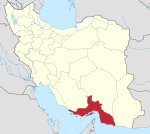Qeshm Island
Qeshm (Persian: قشم, Persian pronunciation: [ɢeʃm]) is an arrow-shaped Iranian island in the Strait of Hormuz, separated from the mainland by the Clarence Strait/Khuran in the Persian Gulf (26°50′N 56°0′E). It is the largest island in Iran.
| Native name: قشم | |
|---|---|
 Qeshm from space, August 2000 | |
 Map of Qeshm Island and surroundings, in French | |
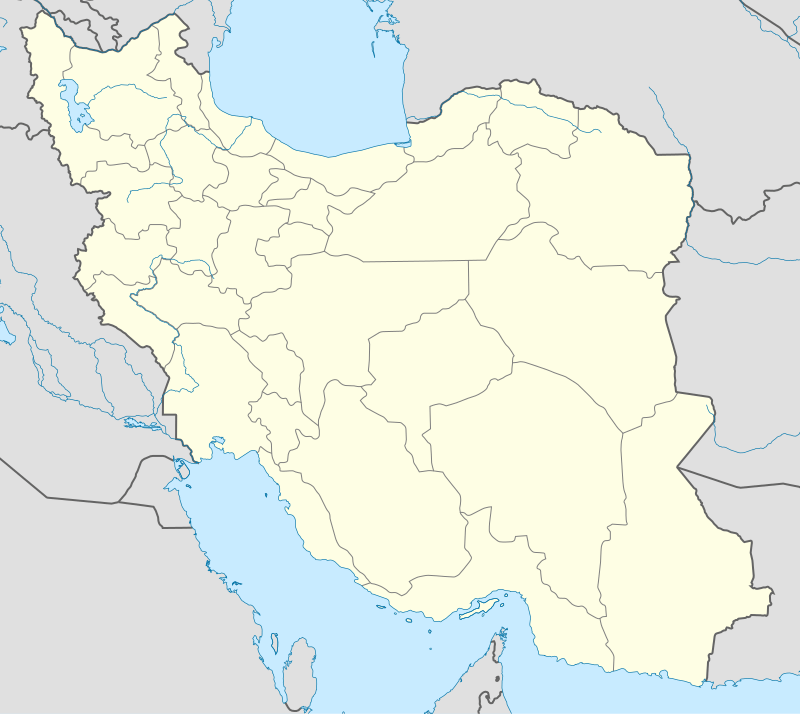 Qeshm Location of Queshm Island in Iran | |
| Geography | |
| Location | Strait of Hormuz |
| Coordinates | 26°41′43″N 55°37′06″E |
| Area | 1,491 km2 (576 sq mi) |
| Length | 135 km (83.9 mi) |
| Width | 40 km (25 mi) |
| Administration | |
| Province | Hormozgān |
| County | Qeshm |
| Bakhsh | Central |
| Largest settlement | Qeshm (pop. 26 807) |
| Demographics | |
| Population | 148,993 (2016) |
| Pop. density | 67.07/km2 (173.71/sq mi) |
| Ethnic groups | Primarily Persian |
Geography
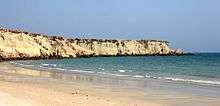
Qeshm Island is located a few kilometers off the southern coast of Iran (Persian Gulf), opposite the port cities of Bandar Abbas and Bandar Khamir. The island, which hosts a 300-square-kilometre (116-square-mile) free zone jurisdiction, is 135 km long, and lies strategically in the Strait of Hormuz, just 60 kilometres (37 miles) from the Omani port of Khasab, and about 180 kilometres (112 miles) from the UAE Port Rashid. The island, at its widest point, located near the center of the island, spans 40 kilometres (25 miles). Similarly, at it narrowest point, the island spans 9.4 kilometres (5.8 miles). The island has a surface area of 1,491 square kilometres (576 square miles) and is 2.5 times the size of Bahrain. Qeshm, located at the easternmost point of the island, is 22 kilometres (14 miles) from Bandar Abbas while the closest point of the island is but two kilometres (1 mile) from the mainland.
The average temperature on the island is approximately 27 °C (81 °F). The warmest months are June through August, and the coldest from October to January. The average rainfall is 183.2 mm (7 3⁄16 in).
The island comprises 59 towns and villages and the population was 117,774 at the 2011 Census. The local population is involved in fishing, dhow construction, trade and services. An additional 30,000 are administrative or industrial workers or students.
Plans have also been made to build a bridge to connect Qeshm with the rest of Iran.[1][2]
Qeshm Island has multiple attractions to attract more domestic and foreign tourists.[3]
History
.jpg)
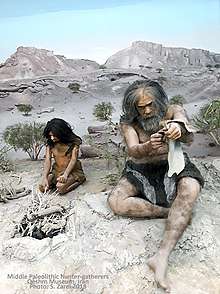
The earliest evidence of human presence at Qeshm dates back to the Paleolithic Period. Paleolithic stone tools have been found at Bam-e Qeshm.[4] Historical records concerning the Qeshm island date far back into the pre-Islamic era. Names as Qeshm, Keshm, Kish and Tunb mark the lengthy stay of Ilamids in the area, several centuries BC. It is, apparently, the island called Alexandria or Aracia by Ptolemy (Book 6, Chap. IV), in the 2nd century CE and as Alexandria by Ammianus Marcellinus (xxiii.6.42) in the 4th century. On account of its strategic geopolitical situation near the mouth of the Persian Gulf, it has been frequently attacked by invaders including Ilamids (Elamites), Umayyads, and Abbasids as well as the Portuguese and the English. During Sassanian Empire administration the island was called Abarkawan, and was part of the Ardashir-Khwarrah administrative division.[5] According to historical records, Qeshm Island has been famous as a trade and navigation center. Its economy flourished during the Dailamites and Buyid eras, as trade vessels sailed between Qeshm Island and China, India, and Africa.
Explorer William Baffin was mortally wounded on Qeshm in 1622 during a battle against Portuguese forces who occupied the fort, known to the English as "Forte de Queixome".
Qeshm is also a supposed site of the Garden of Eden according to Cassell's Bible.[6]
Economy
Fishing is a leading occupation practiced by the inhabitants of the island. On what little cultivated land there is, dates and melons are grown. Salt is mined on the southeastern coast. Qeshm is famous for its wide range of ecotourist attractions such as the Hara marine forests. According to environmentalists, about 1.5% of the world birds and 25% of Iran's native birds annually migrate to the forests, which are the first national geo park in Iran. An ancient Portuguese fort, historic mosques, the Seyyed Mozaffar and Bibi Maryam shrines, and various ponds and mangrove forests are among the tourism attractions in the island, which lays across the azure waters of the Persian Gulf. Several domes, salty caves, the preserved area in Shibderaz Village where Hawksbill turtles hatch, as well as numerous docks and wharfs are among the tourist potentials of the island. The Nazz Islands are located at the south wing of Qeshm Island. Oysters, corals, colorful fishes and sea birds in these islands attract many tourists. It is possible to walk toward the island on soft and wet gravel through a gravel connection way between these islands and Qeshm at the time of the ebb.
 Naaz Islands, sea bed in the time of the ebb
Naaz Islands, sea bed in the time of the ebb.jpg) Sea bed at Naaz Islands
Sea bed at Naaz Islands.jpg) Oysters in the holes of the Sea bed, Naaz Islands
Oysters in the holes of the Sea bed, Naaz Islands.jpg)
.jpg) Qeshm
Qeshm
In the 1st ten-year plan, in note 19, the law provided for the creation of free trade zones and three locations were identified as such in the year 1991. They were Kish Island, Qeshm Island and Chabahar. In the Iranian year 1369, equivalent to 1991 in the Gregorian calendar, the island was transformed into a "Trade and Industrial Free Area" with the goal of creating the largest Free Area between Europe and the Far East.[7] To that end, Qeshm Island was granted considerable leeway to set its own policies, independent of the central government, which had often been seen as an impediment to growth in many sectors of the economy. However, the Island retains the advantages associated with its connection to the mainland, including the rights to explore and develop oil and gas opportunities.
 Portuguese castle at Qeshm Island
Portuguese castle at Qeshm Island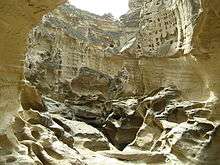 Chahkouh Valley at Qeshm Island
Chahkouh Valley at Qeshm Island Stars Valley at Qeshm Island
Stars Valley at Qeshm Island A tourist running on the island beach
A tourist running on the island beach_003.jpg)
.jpg) Portuguese Castle of the Qeshm town (outside view)
Portuguese Castle of the Qeshm town (outside view).jpg) Portuguese Castle of the Qeshm town (Inside view)
Portuguese Castle of the Qeshm town (Inside view) One of the cannons of Qeshm Portuguese castle
One of the cannons of Qeshm Portuguese castle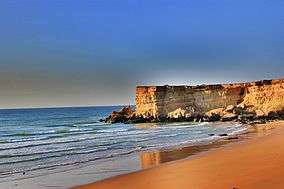
Iran Air Flight 655
On 3 July 1988, an Iran Air Airbus A300 (Iran Air Flight 655) was shot down by a United States Navy guided missile cruiser USS Vincennes just south of the island, resulting in 290 civilian fatalities. The wreckage crashed 2.5 kilometers off Qeshm's southern coast.
Qeshm Island Underground Military Facility
On 20 January 2012, OSGEOINT established the completion of an underground military facility at Qeshm island which accordingly could house Iran's Ghadir-Nahang class submarines.[8]
Economy, culture, and education
- Qeshm Institute of Higher Education
- Islamic Azad University of Medical Science Qeshm International Branch
Visas
Holders of normal passports travelling as tourists can enter Qeshm without a visa with maximum stay of two weeks (extendable), as of December 2017.[9][10]
Admission is refused to holders of passports or travel documents containing an Israeli visa or stamp or any data showing that visitor has been to Israel or indication of any connection with the state of Israel during the last 12 months.[11]
See also
References
- "Austrians to Construct Persian Gulf Bridge to Connect Qeshm Island to the Main Island". payvand.com. Retrieved 2016-10-05.
- "Qeshm – Dictionary definition of Qeshm | Encyclopedia.com: FREE online dictionary". www.encyclopedia.com. Retrieved 2016-10-05.
- "Qeshm Island and its tourist attractions". IFPNews.com. Retrieved 2016-10-05.
- "Iranian Archaeologists Uncover Paleolithic Stone Tools on Qeshm Island - Tasnim News Agency". Tasnim News Agency. Retrieved 2018-07-09.
- Hinds, Martin (1984). "The First Arab Conquests in Fārs". Iran. 22: 39–53. JSTOR 4299735.
- LTD, Kaspid. "Qeshm Island". www.arian-tour.com. Archived from the original on 2017-09-02. Retrieved 2016-08-26.
- Qeshm Island Archived July 4, 2008, at the Wayback Machine, Qeshm Energy International
- Iran: Underground Naval Base at Qeshm Complete. Published by: OSGEOINT. OSGEOINT
- "مزایای ثبت شرکت در مناطق آزاد".
- "No Visa required for Iran free trade zones".
- Visa information on the site of IRI Embassy in Moscow
الكوخردى ، محمد ، بن يوسف، (كُوخِرد حَاضِرَة اِسلامِيةَ عَلي ضِفافِ نَهر مِهران) الطبعة الثالثة ،دبى: سنة 199۷ للميلاد Mohammed Kookherdi (1997) Kookherd, an Islamic civil At Mehran river, third edition: Dubai
- . کامله،القاسمی، بنت شیخ عبدالله، (تاریخ لنجة) مکتبة دبي للتوزیع، الامارات: الطبعة الثانية عام ۱۹۹۳ للمیلاد
- . الوحیدی الخنجی، حسین بن علی بن احمد، «تاریخ لنجه» ، الطبعة الثانية دبی: دار الأمة للنشر والتوزیع، ۱۹۸۸ للمیلاد
- . اطلس گیتاشناسی استان های ایران [Atlas Gitashenasi Ostanhai Iran] (Gitashenasi Province Atlas of Iran)
External links
| Wikimedia Commons has media related to Qeshm Island. |
- Qeshm attractions
- Iran Free Zones official website
- Qeshm Free Zone Organization official website
- Iran's Official Universal Tourism Portal
- Qeshmicty.Ir
- qeshm tourist
- Qeshm Island entry In the Iranica.com
- Hormoz and Qeshm
- Hormozgan'S townships
- Qeshm Island'S attractions
- Portuguese Castle At Wikimapia
